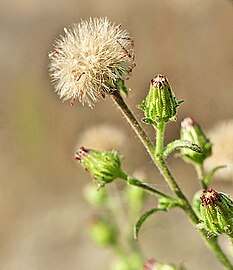fr
noms dans le fil d’Ariane


Mediterranean region.
Mediterranean region, eastwards to Afghanistan and northwest India.
Weed of cultivation, waste ground.
Annual.
Dittrichia graveolens, commonly known as stinkwort[2] or stinking fleabane,[3] is a plant species in the sunflower family, native to southern Europe,[4] North Africa, and western Asia as far east as Pakistan. It has become naturalized in California, Asia, Africa, Australia, and other places and is regarded as a noxious weed in some regions.[5][6][7][8][9] It is a classified as an invasive species in California, and a potential threat to wine production in the state.[10]
The plant is a branching subshrub growing up to 130 centimetres (51 inches) tall, with a rank, foul smell. Leaves are long and narrow, pointed at each end, with small teeth along the edges and glandular hairs on the surfaces. One plant can produce numerous yellow flower heads with as many as 16 ray florets and 40 disc florets.[2]
Barbs on the fluffy-tipped seeds, which help it spread, can fatally damage the digestive systems of grazing animals. Oils in the plant also taint the flavor of meat and milk of animals that have consumed them. The sticky resin has been known to cause allergic reactions and severe dermatitis in humans.[11] For this reasons, it is advisable to wear protective gloves when handling the plant.
Plant in New Zealand
Dittrichia graveolens, commonly known as stinkwort or stinking fleabane, is a plant species in the sunflower family, native to southern Europe, North Africa, and western Asia as far east as Pakistan. It has become naturalized in California, Asia, Africa, Australia, and other places and is regarded as a noxious weed in some regions. It is a classified as an invasive species in California, and a potential threat to wine production in the state.
The plant is a branching subshrub growing up to 130 centimetres (51 inches) tall, with a rank, foul smell. Leaves are long and narrow, pointed at each end, with small teeth along the edges and glandular hairs on the surfaces. One plant can produce numerous yellow flower heads with as many as 16 ray florets and 40 disc florets.
Barbs on the fluffy-tipped seeds, which help it spread, can fatally damage the digestive systems of grazing animals. Oils in the plant also taint the flavor of meat and milk of animals that have consumed them. The sticky resin has been known to cause allergic reactions and severe dermatitis in humans. For this reasons, it is advisable to wear protective gloves when handling the plant.

Plant in New Zealand

Flowers in bloom

Flower (side view)

Flower (overhead)

Flower gone to seed

Dry form of plant